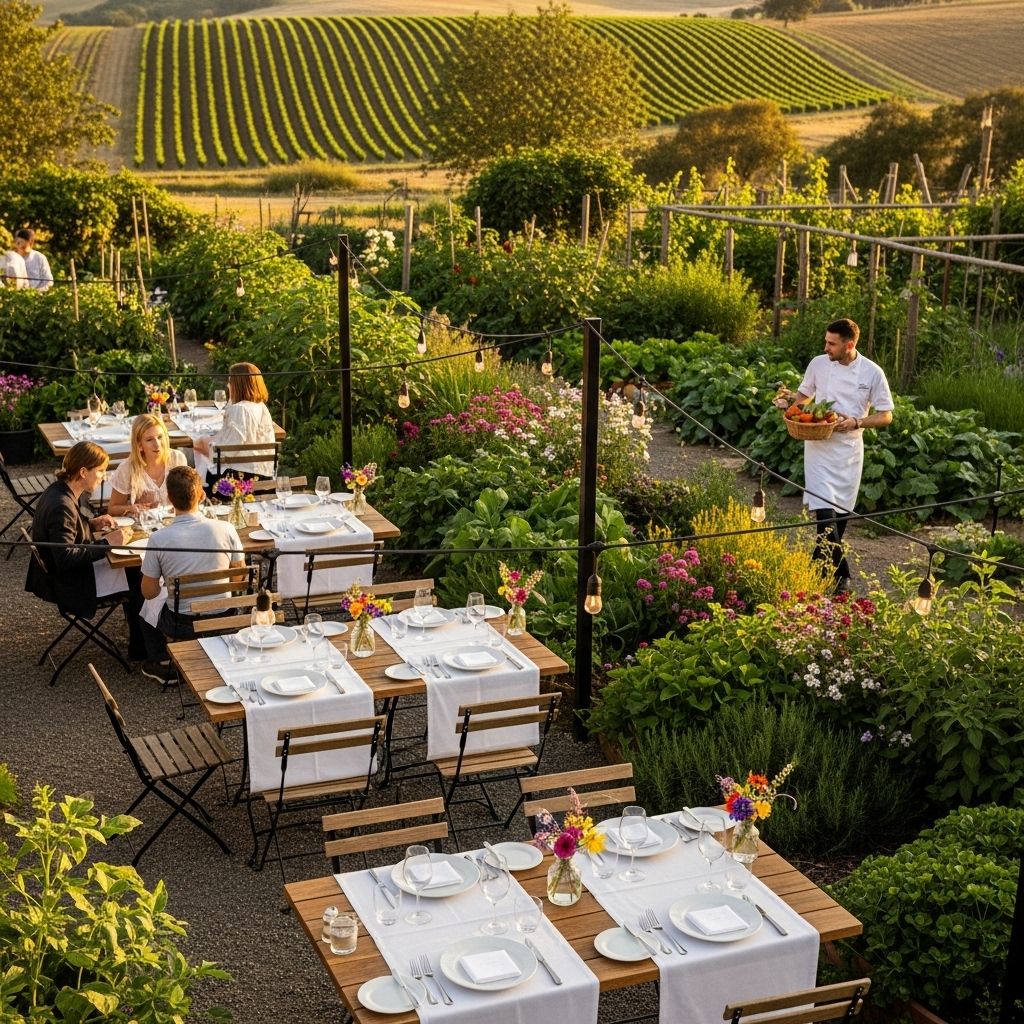Farm to Table Restaurants With Gardens: 11 U.S. Dining Hotspots
Discover innovative farm-to-table restaurants growing their own produce onsite for the freshest, most sustainable dining experiences.

Image: HearthJunction Design Team
Farm to Table: Restaurants With Gardens
Farm-to-table dining has evolved from a culinary catchphrase into a transformative movement shaping how chefs and diners connect with food. Across the United States, a select group of pioneering restaurants are taking the concept one step further—not just sourcing from local farms, but cultivating their own produce right on their rooftops, behind the kitchen, or even on the restaurant grounds. From Seattle to Maine, we profile 11 innovative restaurants where the garden is as integral to the experience as the dining room itself.
Why Restaurants Grow Their Own Produce
Chefs and restaurateurs are increasingly turning to on-site gardens for logical and inspiring reasons:
- Cost Efficiency: Reducing the need for third-party suppliers cuts costs and ensures better margins.
- Ultimate Freshness: Ingredients go from soil to plate in minutes, preserving flavor and nutrition.
- Creative Control: Chefs can select rare or heirloom varieties unavailable from larger distributors, customizing menus to seasonality and inspiration.
- Sustainability: Decreasing transportation needs slashes the carbon footprint, while composting and organic methods minimize environmental impact.
- Guest Engagement: Diners can experience the garden firsthand, gaining new appreciation for the food’s journey.
America’s Most Innovative Farm-to-Table Restaurants
Below is a curated look at 11 standout establishments, each blurring the line between farm and fork in their own inventive way.
1. The Herbfarm – Woodinville, Washington
The Herbfarm has set the standard for garden-integrated dining since 1986. Tucked inside a charming cottage in the Woodinville wine region, this five-diamond restaurant delivers elaborate multicourse menus that change daily, based on the peak flavors harvested from their kitchen gardens mere hours before service. Herbs, edible flowers, and produce are picked fresh by the chefs themselves, ensuring each plate embodies the region’s bounty. Guests can stroll the gardens before their meal and learn about organic gardening and rare plant varieties. Sustainability, seasonality, and culinary artistry converge for one of the Northwest’s most unique dining experiences.
- Seasonal nine-course dinners inspired by the garden at its peak
- Wine pairings showcasing Washington’s best vineyards
- Educational garden tours for guests
2. Canoe – Atlanta, Georgia
Set on the lush banks of the Chattahoochee River, Canoe offers more than just a scenic dinner spot—it boasts an expansive garden with 12 raised beds covering over half an acre. Executive Chef Carvel Grant Gould transforms these homegrown vegetables and herbs into vibrant New American dishes, such as Carolina rabbit with chard-and-bacon ravioli and sweet potato hash. Guests are encouraged to arrive early and wander the riverside paths lined with wildflowers, vegetables, and compost piles. The landscape seamlessly blends ornamental and edible beauty for a truly immersive, eco-friendly dining experience.
3. Lavomatic – Cincinnati, Ohio
Cincinnati’s Lavomatic takes urban gardening to new heights—literally. Their rooftop garden grows herbs and vegetables that don’t just supply Lavomatic but also support two sister restaurants under the Relish Group. Chief Operating Officer and head gardener Justin Dean manages this compact, high-yield plot, sourcing 15–20% of the kitchen’s produce needs right from the rooftop. Additional local partnerships ensure that the rest of the menu is equally fresh and regionally rooted. The garden demonstrates how creative spaces in the city can foster profound connections between food and place.
4. Blue Hill at Stone Barns – Pocantico Hills, New York
Blue Hill at Stone Barns is synonymous with the American farm-to-table movement. Nestled within the sweeping fields and greenhouses of Stone Barns Center for Food & Agriculture, Chef Dan Barber’s restaurant is entirely supplied by its own working farm and research facility. The menu, written daily, spotlights just-harvested greens, heritage grains, and pasture-raised meats, with guests encouraged to stroll the grounds and observe the farm’s innovative sustainable practices.
5. Blackberry Farm – Walland, Tennessee
The picturesque foothills of the Smoky Mountains are home to Blackberry Farm, a culinary destination renowned for its artisanal cheeses, heirloom vegetables, and heritage-breed livestock—all raised on its sprawling 4,200-acre property. Guests can join garden tours, cheese-making workshops, and even participate in seasonal harvests, forging a direct connection with the land and the flavors it yields. Chef-driven menus shift constantly to celebrate each day’s freshest ingredients.
6. Husk – Charleston, South Carolina
At Husk, the phrase “if it doesn’t come from the South, it’s not coming through the door” sets the tone for a fiercely regional menu. The historic downtown property features a kitchen garden where peppers, tomatoes, and herbs are raised for dishes that reinterpret classic Southern fare. Relationships with local farmers and purveyors supplement the harvests, and guests can dine amidst a living display of the Lowcountry’s agricultural richness.
7. Arrows Restaurant – Ogunquit, Maine
Arrows is a New England institution, famous for cultivating over two acres of organic vegetables, herbs, and edible flowers just steps from the dining room. For more than 20 years, chefs Mark Gaier and Clark Frasier have overseen every aspect of the garden and menu creation, delivering hyper-seasonal dishes that reflect Maine’s changing landscapes. The garden is intentionally visible to guests, conveying transparency and pride in the culinary process.
8. The Restaurant at Meadowood – St. Helena, California
Set in the heart of Napa Valley, The Restaurant at Meadowood draws inspiration—and ingredients—from its own biodynamic gardens. Chefs collaborate with the gardening team to cultivate rare crops and botanicals, integrating them into a tasting menu that captures the essence of wine country. Diners can explore the gardens, learn about biodynamic methods, and taste the land’s abundance in every thoughtfully prepared dish.
9. Ubuntu – Napa, California
Ubuntu redefined vegetarian cuisine by placing the garden at the center of the culinary experience. Their rooftop and backyard gardens supply organic vegetables and edible flowers for a creative, entirely plant-based menu. Chefs work closely with gardeners, even incorporating yoga and mindfulness into daily routines, fostering a holistic approach to farm-to-fork hospitality.
10. Sweet Basil – Vail, Colorado
Located in the mountain resort town of Vail, Sweet Basil maintains an on-site herb garden and collaborates with local farms to keep its menu both rooted and adventurous. Dishes feature just-picked herbs and greens, supporting the restaurant’s philosophy of local flavor and freshness, even at high altitude.
11. Founding Farmers – Washington, D.C.
Founding Farmers in the nation’s capital stands out for its rooftop aeroponic towers. These vertical gardens grow lettuces, herbs, and edible flowers used in salads and garnishes, maximizing limited urban space with innovative technology. This modern, efficient system provides year-round fresh produce with minimal environmental impact, serving as a model for urban agriculture nationwide.
Trends and Innovations in Restaurant Gardens
While the methods and settings vary, several common trends unite these visionary establishments:
- Raised Beds: Offer efficient, manageable growing spaces in urban and suburban settings.
- Rooftop Gardens: Transform otherwise unused space into productive, beautiful oases.
- Aeroponic Towers: Allow for high-yield, soil-free cultivation in dense cities, reducing water use.
- Integration with Dining Experience: Menus reference ingredients grown steps away, and many restaurants encourage tours and tastings in the garden.
Dining Amidst the Garden: Guest Experiences
Visiting a restaurant with an on-site garden is about more than the meal—it’s a multisensory journey:
- Garden Tours: Many restaurants offer guided walks, where diners can see, touch, and taste seasonal produce in its natural habitat.
- Education: Guests often learn about composting, organic growing methods, and the role of biodiversity in flavorful food.
- Cooking Classes: Some establishments invite guests to harvest ingredients and join chefs for hands-on kitchen workshops.
- Scenic Ambience: Lush gardens, river paths, and mountain views set an unforgettable scene.
Benefits of Onsite Gardens for Restaurants
| Benefit | Description |
|---|---|
| Cost Savings | Reduces reliance on external suppliers and transportation costs. |
| Seasonal Menus | Enables chefs to craft dishes based on what’s perfectly ripe. |
| Sustainability | Minimizes environmental impact by cutting down food miles and chemical usage. |
| Guest Engagement | Enhances the dining experience with interactive and educational opportunities. |
| Flavor & Nutrition | Maximizes freshness, taste, and health benefits. |
Challenges of Restaurant Gardening
- Space Limitations: Especially in urban environments, garden space is precious and requires creative solutions like vertical or rooftop gardening.
- Labor and Expertise: Caring for a productive garden demands significant time, horticultural knowledge, and collaboration between chefs and gardeners.
- Seasonal Variability: Weather and growing cycles require flexible menu planning and supplemental sourcing from nearby farms.
Frequently Asked Questions (FAQs)
What does “farm-to-table” mean in the context of these restaurants?
Farm-to-table refers to restaurants sourcing most or all ingredients directly from farms, often their own, ensuring the freshest, most seasonal produce reaches the plate with minimal transport and handling.
Can diners visit the gardens?
Yes, many farm-to-table restaurants with gardens encourage guests to tour or even help harvest from their gardens, offering educational experiences and a deeper connection to their food.
Do restaurant gardens supply all their ingredients?
While many restaurants supply a significant portion of their produce from their own gardens, most still rely on local farms and purveyors for items not grown on-site or out of season.
How do urban restaurants manage to grow produce onsite?
Urban restaurants make use of rooftop gardens, raised beds, recycled containers, or aeroponic towers to maximize production on limited ground.
What are some other sustainable practices at these restaurants?
Common practices include composting kitchen waste, using organic gardening methods, supporting local farmers, and integrating sustainable seafood and meat sourcing with on-site produce.
Conclusion
From rustic mountain inns to sleek city rooftops, America’s farm-to-table restaurants with gardens exemplify a commitment to sustainability, creativity, and culinary excellence. Their gardens not only supply the kitchen with ultra-fresh ingredients but also reconnect chefs and diners with the rhythms of the natural world. As this movement grows, so does the potential for transformative, delicious, and responsible dining experiences everywhere.
References
- https://www.theherbfarm.com
- https://www.opentable.com/cuisine/best-farm-to-table-restaurants-seattle-wa
- https://www.emeraldpalate.com/farm-to-table-restaurants-in-seattle/
- https://www.willowslodge.com/woodinville-restaurants/the-herbfarm/
- https://www.gardendesign.com/pictures/farm-to-table-restaurants-with-gardens_142/
Read full bio of Shinta












